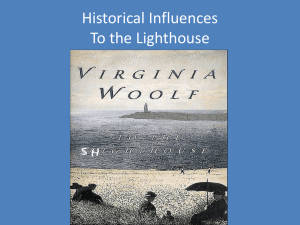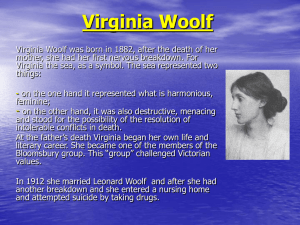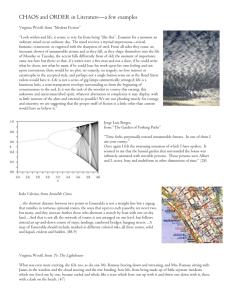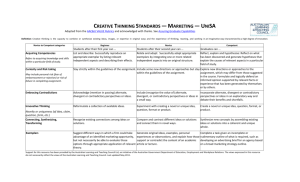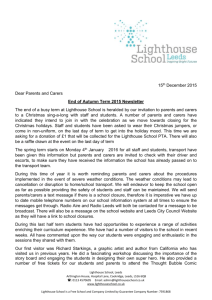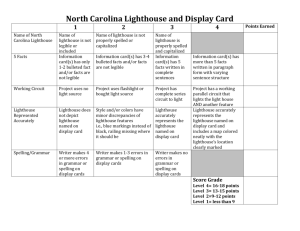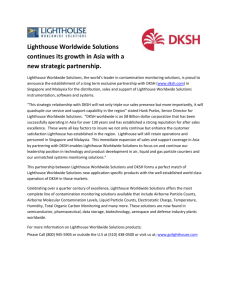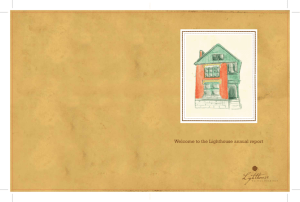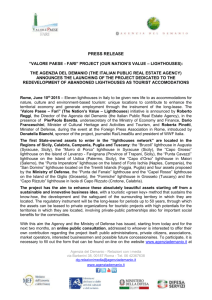November 2015 - WordPress.com
advertisement
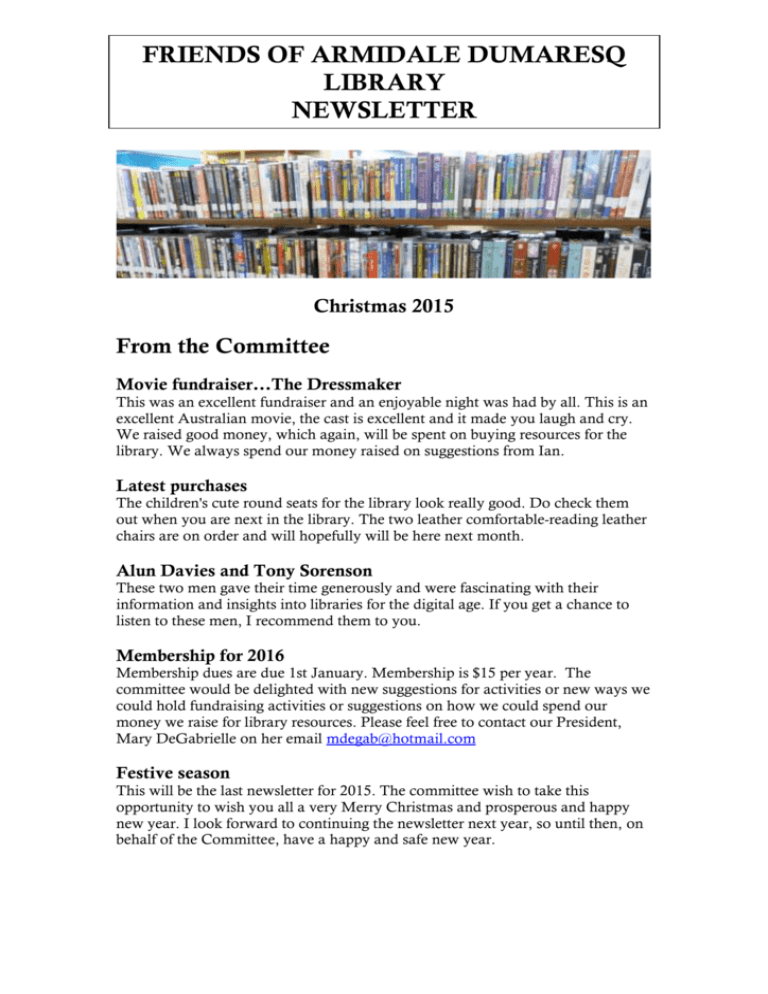
FRIENDS OF ARMIDALE DUMARESQ LIBRARY NEWSLETTER Christmas 2015 From the Committee Movie fundraiser...The Dressmaker This was an excellent fundraiser and an enjoyable night was had by all. This is an excellent Australian movie, the cast is excellent and it made you laugh and cry. We raised good money, which again, will be spent on buying resources for the library. We always spend our money raised on suggestions from Ian. Latest purchases The children's cute round seats for the library look really good. Do check them out when you are next in the library. The two leather comfortable-reading leather chairs are on order and will hopefully will be here next month. Alun Davies and Tony Sorenson These two men gave their time generously and were fascinating with their information and insights into libraries for the digital age. If you get a chance to listen to these men, I recommend them to you. Membership for 2016 Membership dues are due 1st January. Membership is $15 per year. The committee would be delighted with new suggestions for activities or new ways we could hold fundraising activities or suggestions on how we could spend our money we raise for library resources. Please feel free to contact our President, Mary DeGabrielle on her email mdegab@hotmail.com Festive season This will be the last newsletter for 2015. The committee wish to take this opportunity to wish you all a very Merry Christmas and prosperous and happy new year. I look forward to continuing the newsletter next year, so until then, on behalf of the Committee, have a happy and safe new year. Book review To the Lighthouse Virginia Woolf This novel by Virginia Woolf was first published in 1927, and is widely regarded as one of her finest works. The first section of the book, “The Window”, introduces the Ramsey family and some of their friends throughout one day at their seaside summer house. The lighthouse of the title appears at the outset, and visiting it is the particular desire of James, the youngest of the Ramsey children. In the middle section, “Time Passes”, the family is absent from the summer house and it falls into decrepitude over the ten years prior to their again visiting the seaside. In this middle section we also learn the fate of the some of the family members in short parenthetical sentences, which punctuate the description of the house’s decay. In the final section, “The Lighthouse”, the long delayed visit to the lighthouse is finally accomplished. The prose of the novel is deceptively simple. Woolf employs the literary technique of stream-of-consciousness, with little dialogue and not much action. The reader is made privy to the thoughts and perceptions of each of the characters. In this way the marriage of Mr and Mrs Ramsey is explored as well as the personalities, hopes and emotions of their various friends. I did not find this book an easy read at first and I don’t think it would appeal to everyone. However, I became more and more engrossed in its beautiful writing, especially the wonderfully evocative middle section. The lighthouse opens and closes the book, remaining a symbol of constancy throughout its ten year span. Despite death, decay and the vicissitudes of life, the lighthouse’s steady beam remains. Marnie French. New in the Library The “Best books of the year” lists are starting to be published in the run-up to Christmas, and it’s pleasing to report that the Library already has many of those titles available for you to borrow. Here’s an idea: why not wrap one up, if it’s the thought that counts? Would it be too challenging to see experience as more valuable than possession? Indeed, the joy of giving a new Library book to someone for Christmas will only be increased in the knowledge that it can be shared with others, won’t take up valuable space in the home for more than three weeks and, if it is an unsuitable read, it can be replaced by another from the Library shelves. For those of you entertaining young family members, there are DVD Adventures of Paddington Bear, Jimmy Neutron boy genius and Milo and Otis. There are all three Free Willy movies, and more charming Madeline cartoons than could be absorbed in a single sitting. For your own relaxation, try Beyond El Rocco, a documentary story of the Australian modern jazz movement since the 1950s (featuring Stewie Speers, Don Burrows, Bernie McGann and others). Similarly Australian is The Castanet Club: a movie you can dance to (“A bonzer night out with the celebrated cabaret team from downtown Newcastle, the Castanet Club, filmed live at the North Bondi RSL Club”). Café Lumiere, by the acclaimed Taiwanese director Hou Xiaoxian, is beautifully described: “Yoko, a freelance writer, becomes pregnant and chooses, against tradition and her parents' wishes, to raise the baby alone. In her loneliness and confusion, Yoko befriends the owner of a second-hand bookstore, who silently falls in love with her as she contemplates the choice she has made”. More disturbing, but at least leavened with satire, is the British series Black mirror (“We have access to all the information in the world, but no brain space left to absorb anything longer than a 140-character tweet”). Titus Welliver makes a suitably taciturn Bosch in the Los Angeles adaptation of a Michael Connelly police drama. Revisit brutality on the Bounty with this 1984 re-telling, starring Mel Gibson, Anthony Hopkins, Edward Fox and Laurence Olivier (“they were friends through hell. They became enemies in paradise”). The emperor’s naked army marches on documents atrocities within the Japanese army in World War II. Even more remarkable are two confronting Indonesian documentaries by Joshua Oppenheimer: The act of killing and The look of silence. The first examines a country where death squad leaders are celebrated as heroes. The film-makers challenge them to re-enact their real-life mass-killings in the style of the American movies they love. The second shows a family that survived the political anti-communist genocide in Indonesia confronting the men who killed one of their brothers. Even now (the film was released in 2014) many of the end credits appear as "anonymous" on the film for fear of government retribution and assassination. If historical romance is more to your taste, why not consider a Hunchback of Notre Dame festival? We have recently added to the Lon Chaney (1923), Charles Laughton (1939) and Walt Disney (1996) versions with Anthony Quinn (1956) and Anthony Hopkins (1982). If music be the food of love, play on with Ba power of Mali with Bassekou Kouyate and Ngoni Ba. Eugene Hideaway Bridges, who has visited Australia thirty times, urges us to Hold on a little bit longer. Signature Sounds, a little company in western Massachusetts, has proudly released a 20th anniversary collection called Rarities from the second decade, and there are some lovely tracks inside. To help celebrate Christmas in the new century, Derek Sandhaus has written about Baijiu: the essential guide to this distilled Chinese spirit. If you need to escape the everyday in other ways, there are new Lonely Planet guides to Bali and Lombok, Beijing, Croatia, Denmark, East Africa, Hungary, Norway, Switzerland and Turkey. Chris Impey dares to suggest a less-than-everyday destination with Beyond: our future in space. Further on the pursuit of pleasure and relief, Marc Lewis suggests, in The biology of desire: why addiction is not a disease, that new knowledge about brain plasticity gives hope for a new model of healing addictions. For further good news about brains, try Tom Clynes’ The boy who played with fusion: extreme science, extreme parenting and how to make a star (“By the age of 11, Taylor Wilson had mastered the science of rocket propulsion. At 13, his grandmother's cancer diagnosis drove him to investigate medical uses for radioactive isotopes. And at 14, Wilson became the youngest person in history to achieve nuclear fusion”). Hal Whitehead shows how the capacity for learning is not only characteristic of humans in The cultural lives of whales and dolphins. Nathaniel Popper explains a new kind of learning in Digital gold, subtitled Bitcoin and the inside story of the misfits and millionaires trying to reinvent money. Lucy Johnston does the same for craft in Digital handmade: craftsmanship in the new industrial revolution. Ashlee Vance brings us more in the same brave new mode, with Elon Musk: Tesla, SpaceX and the quest for a fantastic future. And Nicholas Carr examines The glass cage of automation and us. Yoshihito Isogawa brings us three Lego Technic ideas books to fill every quiet moment of the holiday period: simple machines, fantastic contraptions and wheeled wonders. Christa Rolf also brings practical instruction with How to sew beautiful aprons. Nigel Slater returns with a third volume of The kitchen diaries: a year of good eating, produced just as beautifully as its predecessors. Re-designing? Try Terence Conran on colour. Victoria Carey displays Australian Country style homes. Alan Weintraub has photographed Frank Lloyd Wright: the rooms interiors and decorative arts. Outdoors, Jonas Reif encourages Cultivating chaos: showing how to enrich landscapes with self-seeding plants. Joy Hinson illustrates our long historical association with the Goat. Cate Foster illustrates Small house living with examples of designconscious New Zealand homes of 90m2 or less. Bob Harden has produced an amazing local study with European settlement and pastoralism at Kunderang, upper Macleay River, 1840-1960: oral history, documentary research, maps and photographs. Australian childhood is remembered by Richard Glover in Flesh wounds, and by Tim Winton in Island home: a landscape memoir. Jamie Maslin, on the other hand, leaves Tasmania to carry out The long hitch home to England, with a remarkable detour to Shipton’s Arch in western China’s Xinjiang Uyghur Autonomous Region. Rachel Mairs looks at Afghanistan through a different lens, marshalling coin, documentary and archaeological evidence about The Hellenistic far east to show the long-term leftovers of Alexander the Great concerning archaeology, language and identity in Greek Central Asia. Richard Stoneman resurrects the achievements of Xerxes from the depredations of Alexandrian propaganda, giving a nuanced portrait of a man who ruled a vast and multicultural empire which the Greek communities of the West saw as the antithesis of their own values. The examination of national characteristics can lead to unjustified prejudice if not handled sympathetically: the Independent review of Sudhir Hazareesingh’s How the French think leads off with the old joke “How do you tell the difference between a British official and a French one? The Briton says: "This idea works fine in theory but will it work in practice?" The Frenchman says: "This idea works fine in practice but will it work in theory?" –luckily, the book is more complex than that (subtitled an affectionate portrait of an intellectual people), and more wonderful for it. Lauren Holmes openly explores varieties of human behavior in her debut short story collection, Barbara the slut and other people. Lucia Berlin has achieved fame for her posthumously published short story collection A manual for cleaning women – women who are lost, strong, clever and real. Also from America is Karl Greenfeld’s The subprimes – “In a future America that feels increasingly familiar, you are your credit score. Extreme wealth inequality has created a class of havenothings: Subprimes. Their bad credit ratings make them unemployable. Jobless and without assets, they've walked out on mortgages, been foreclosed upon, or can no longer afford a fixed address. Fugitives who must keep moving to avoid arrest, they wander the globally-warmed American wasteland searching for day labor and a place to park their battered SUVs for the night”. America’s favourite big author, Jonathan Franzen, has been recognized with a beautiful reprint of 2001’s The corrections. A publisher in Portland has brought out Peter Doyle’s new Sydney mystery, The big whatever (the hero thinks “He may as well have gone straight, it’s so boring”). Meanwhile in England, Matthew Baylis’ reporter, Rex Tracey, investigates a Black day at the Bosphorus Café. Andrea Camilleri, too, returns with his admirable hero Inspector Montalbano for two more tilts: at the Blade of light and a Game of mirrors. JK Rowling returns in her guise as Robert Galbraith with hero Cormoran Strike in Career of evil. John Banville explores the theft that is adultery in The blue guitar. Ruth Rendell’s final novel, Dark corners, is also available. Ann Granger’s Dead in the water is a fourth Campbell and Carter mystery. JD Robb’s extensive in death series is extended one more with Devoted. Robert Harris continues his Cicero series in ancient Rome with the 449-page Dictator. At the other end of things, Greg Egan’s Distress begins “It is the year 2055, and the battle of the sexes has seven combatants rather than two”. And a third story of conflict is Evie Wyld’s graphic novel, Everything is teeth, based on the sharks of an Australian childhood remembered in England. Margaret Atwood’s new novel posits sacrifice of freedom for comfort, in The heart goes last. Kate Morton matches glamour and mystery at The lake house. Naomi Williams recreates La Perouse’s 18th-century fantastic voyages in Landfalls.
